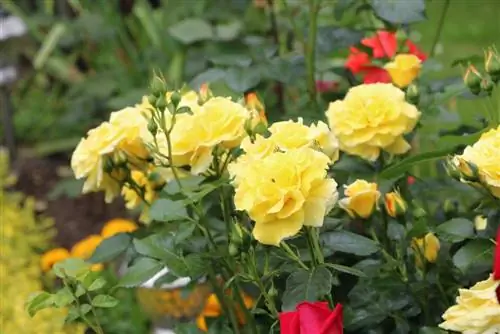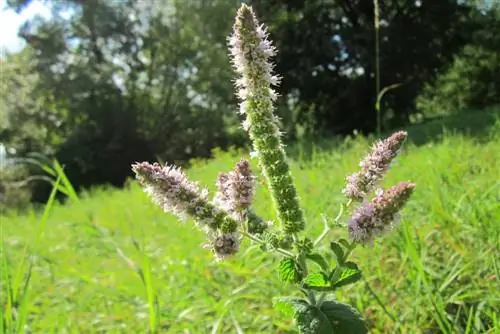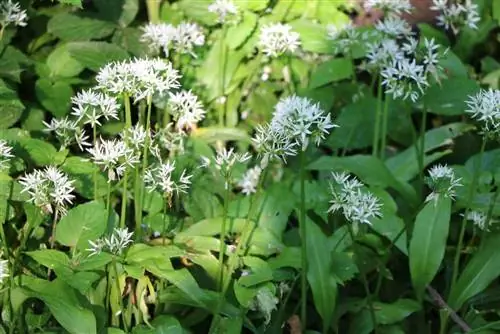- Author admin [email protected].
- Public 2023-12-17 03:39.
- Last modified 2025-01-24 12:45.
Titleflowers (Iberis) belong to the cruciferous family, which can be found in many species, especially in rock gardens. They come from the Mediterranean region, where they are represented by more than 30 varieties. Candytufts are often annual plants, but most of them are popular for their flowers and stay in place for several years.
Some specimens grow herbaceously, others develop to the height of a small bush. Candytufts are mostly known under these variants:
- Bitter candytuft (Iberis amara)
- Evergreen Candytuft (Iberis sempervirens)
- Amber Candytuft (Iberis umbellata)
The candytuft not only finds a good location in the rock garden, it also surprises with its beautiful, approx. 5 cm large flowers. They suit the atmosphere in such a garden; they would like to grow sunny and in barren soil, just as they are used to in the Mediterranean region. A flower head consists of countless individual flowers that come in different colors. Many shades are available from white to pink, crimson or red. Some candytufts are evergreen plants and decorate the flower bed all year round with their sometimes fleshy leaves.
The distribution area of the candytuft is the European region and especially the southern part. Spain, France and Italy, but also the Balkans, Africa and Morocco can be home to this sun-drenched plant.
Tip:
Straight flowering stems can be placed in the vase.
Location for the candytuft
Titleflowers are available as seeds in many varieties. So they can be sown directly on the spot in early spring between March and April, which can be done easily and without much effort. The first small plants appear after around two weeks. From the large number of these seedlings, the garden owner should choose the strongest ones and plant them thinly at a distance of 10cm. Even though ribbon flowers themselves look very interesting due to their play of colors, they can create a beautiful picture when combined with ice plants. Their variety of colors complements the countless small flowers of the candytuft wonderfully. The scabiosis, which also goes well with candytufts with its pink flower heads, is also a good neighbor.
The soil where the candytuft is located should be slightly dry and have a slightly acidic to alkaline environment. The location should of course be sunny, just as the plant knows it from its origins. Sandy and loamy mixed soils that are rich in nutrients are ideal. Although the plant loves warmth, it is still frost hardy. Night frosts also occur in its home countries, which is why it can be easily cultivated in the relatively cool regions of Germany.
Tip:
The flowering period of the candytuft ranges from May to August.
With one or two tips you can promote the growth of the candytuft and improve flower formation. Providing sufficient water in spring helps prevent the flowers from opening too early and instead allows them to gather some strength for a lush size. On the other hand, the candytuft blooms a little later in the year, but that basically doesn't represent a loss. The garden owner's patience is then rewarded with larger and more beautiful flowers.
Ribbon flowers are ideal for quickly closing gaps in beds with beautiful flowering plants. If the location is right, it can be planted as a neighbor to many other varieties, usually right at the edge of a bed. Here it is suitable for planting in the foreground due to its low growth height.
Care and pruning of the candytuft
If the candytuft stems are cut back after flowering and fed with liquid fertilizer, they will sprout a second time and once again form a beautiful carpet of flowers. This will be the case until August, because the candytuft flowering period lasts until then. By pruning, the gardener ensures that new flowers form again and then show their beautiful play of colors again in September. However, this pruning also has other advantages:
- It not only ensures beautiful growth and additional abundance of flowers,
- but also so that the plant can sprout more easily next spring.
Tip:
However, you should only cut back to a height of 10 cm. The more woody the plant is, the less pruning it is!
If you not only cut the plant back regularly, but also cut off flower stalks for the vase beforehand - keeping an eye on development - the growth habit can also be influenced. However, the gardener should only cut until early autumn so that the candytuft has formed new shoots by the onset of winter. The plant is hardy and does not need any special protection; placing a little pine twigs over it helps prevent snow from crushing the plant.
Propagate the candytuft
The gardener doesn't need to do anything to make the candytuft bigger and more lush. It is self-seeding and therefore reproduces on its own unless you prevent it from doing so by removing shoots. The flowers of self-sown plants appear a little earlier than those of plant parts cultivated by humans. If you want to propagate an existing plant through cuttings, this is just as easy. Cut branches are placed in a flower pot so that they can root there in peace. This is quick and so they can be planted in the flower bed a short time later. These actions should be carried out in summer.
Potential pests of Iberis
Basically, the candytuft is a robust plant. It is relatively rarely sick and is only attacked by pests that move from neighboring plants. These are usually aphids, but a certain fungus can also attack the plant. It causes the so-called “dropping-off disease”, i.e. H. the candytuft is damaged in its roots. This causes it to collapse above ground and die.
Attention:
Remove affected plants immediately and throw them in the trash, not in the compost!
No new sowing or planting should be carried out where a diseased plant has stood, as other disease germs may still be present in the soil. These would immediately infect the next plant again.
What you should know about candytuft soon
Titleflowers are making a comeback in spring gardens. They bloom white and fragrant, and the inflorescence can be extended and easily reactivated by cutting off the umbels that have already bloomed. The candytuft has annual as well as perennial species. The perennial is recommended in the garden because after just a few years it forms small, woody bushes up to 40 cm high, which are decorated all over with white umbels. It contrasts in color and size with the early cushion flowers, for example.
- The candytuft blooms from May to August. It is also nice when the petals on the umbels have withered and fall off in a light wind. The plants underneath then look like they have been dusted with powdered sugar. Small pods form from the flowers. However, the seeds of some species are slightly poisonous, so you should exercise caution in the garden with small children.
- The candytuft's preferred locations are dry and clayey soils. It also loves stony and calcareous surfaces in which it can settle. And she prefers to squint at the sun with her flowers; she prefers sunny locations. Since the flowers have a very light and delicate scent, it is also recommended to plant them near a bench and, depending on the wind, you can then enjoy the delicate, intoxicating scent of the candytuft.
- The candytuft is no longer often used as a medicinal plant at home today. However, the effect of candytuft is still used by the pharmaceutical industry. The active ingredients of candytuft can be found in a wide variety of stomach and intestinal preparations. If you want to use the candytuft as a medicinal plant, you can make an infusion or squeeze the leaves. But be careful, it tastes very, very bitter, because it bears its name, bitter candytuft, for good reason!






